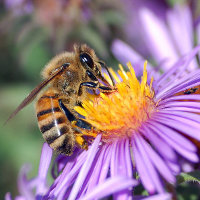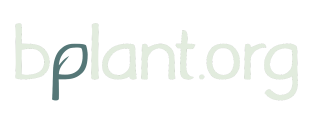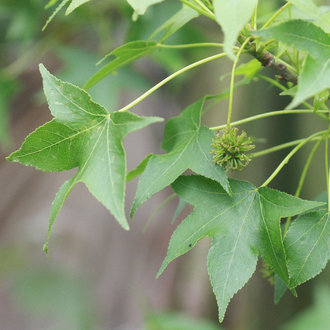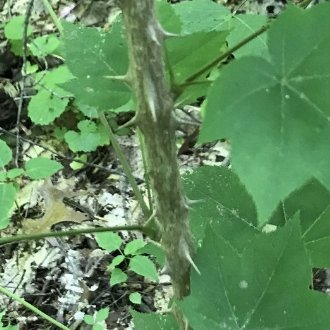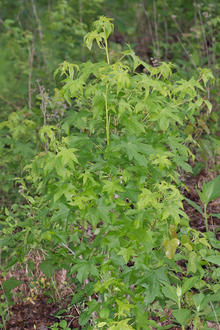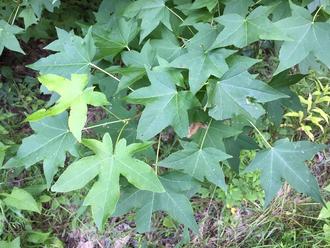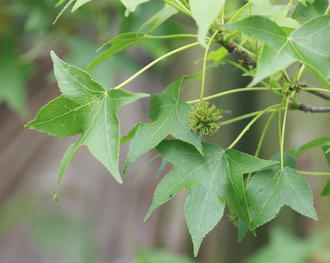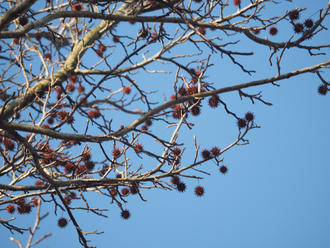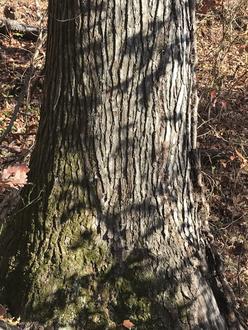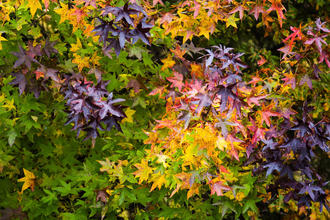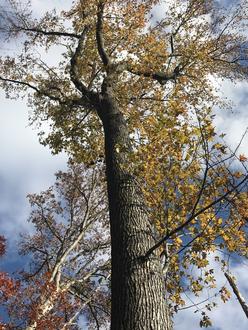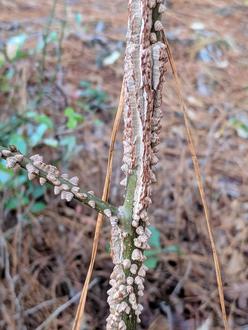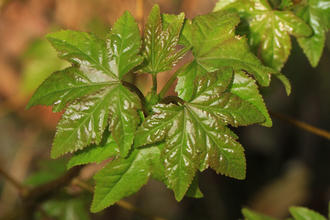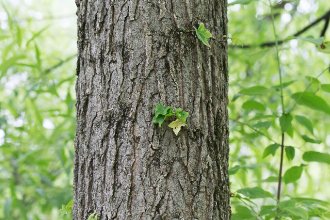American Sweetgum (Liquidambar styraciflua L.)
↑Summary
A distinctive tree with star-shaped leaves and hard, spiky fruits. Native to southeastern North America where it tends to be found on moist to wet sites.
↑Range - Expand
| Legend | Color |
| Native or Not Present | |
| Native | |
| Native or Expanded | |
| Introduced | |
| Not Present |
This tentative map is based on our own research. It may have limited data on Canada and/or Mexico, and there is some subjectivity in our assignment of plants as introduced vs. expanded. Read more in this blog post.
Although this plant occurs somewhere in each of these regions, it may only occur in a small part of some or all of them.
This species is also native to Mexico; we have yet to build this portion of its map.
↑Similar Plants
↑Habitat
Sweetgum is found in the southeastern US, mostly but not exclusively on moist sites, including floodplains and bottomlands, especially along streams and rivers, and sometimes in depressions and seeps in upland areas. It is rare to occasional on better-drained upland sites, where it can survive but is less competitive. It tolerates poor drainage and areas that flood temporarily, but not prolonged flooding.
It can be a dominant and persistent canopy tree on wet bottomland sites. On better-drained sites and sites with average moisture levels, it is usually a temporary and only occasional species which colonizes disturbed sites, only scattered trees surviving to persist in the forest canopy, and eventually being replaced by more shade-tolerant species. On better-drained portions of bottomlands it is often replaced by various bottomland oaks.
Sweetgum tolerates a range of soil textures, but is rare on soils with a high portion of sand because they tend to be too well-drained. In most regions it is more dominant on poorly-drained soils with a high clay content. However, in the lowest parts of the Mississippi delta, it is limited to sites with a higher portion of silt and less clay. It tolerates a wide range of soil pH, typically from 5 to 6.8, but usually prefers soil towards the lower end of this range.
It is intolerant of fire and generally absent from areas that burn regularly.
↑Life Cycle
Seedlings develop quickly. The root structure varies considerably by sites. On deeper, well-drained soils, the tree produces a long taproot, but on wet, poorly-drained sites a taproot may be poorly-developed or missing entirely, with the tree developing extensive shallow, spreading roots. On ideal sites the tree may grow as high as 2 feet in the first year. Although seedlings usually grow best in full sun, they can exhibit some shade tolerance on wet sites.
Trees begin producing seed around 20-30 years of age, and continue producing good crops for about 150 years. Significant seed is produced every year, but every 2-3 years there is a somewhat larger crop. Seed is mostly dispersed by wind, with most seed falling with 200ft (60m) from the tree, and some traveling up to 600ft (183m.)
Sweetgum is windfirm and highly resistant to wind damage, often being one of the hardwood species least-damaged by major storms such as hurricanes and tornadoes. Its structure is such that small twigs are only weakly attached but the central trunk and larger branches are more sturdy. Thus in violent wind, it sheds numerous small twigs which reduces wind drag, keeping the rest of the tree intact.
It is less resistant to fire. Trees younger than about 50 years of age are able to resprout if top-killed by fire, harvesting, or other mechanical damage. Sprouts grow rapidly, often growing 4.5ft (1.4m) in one season. Although relatively thin-barked, mature trees have a high capacity for healing from low-intensity fire and mechanical damage, through a gum exuded from the sapwood, which protects the sapwood and allows the bark to regrow. Fire can however kill sweetgum by depleting its energy reserves as the tree expends energy to heal.
↑Uses
The wood is used for lumber, veneer, and plywood. The wood is easy to work, but prone to warping during drying. The sapwood of this species is thick and has poor durability; because the sapwood is so thick, only larger trees yield sufficient heartwood. The heartwood is darker and more durable.
Sometimes used as a landscaping plant, where it is valued for its striking fall color, with a single tree often showing a rainbow of colors including green, yellow, orange, red, and purple, all at the same time.
Some cultivars exist with altered characteristics, including a round-leaved cultivar that is sometimes confused with other species, a "weeping" variety with hanging branches, and a columnar variety with a narrow, upright growth habit.
↑Related Plants
This is the only Liquidambar species in North America, and there are no other genera in the Altingiaceae family. The broader Saxifragales order is a huge grouping that contains many native and introduced species.
Of these, the most closely related genera that are also found in North America include plants of two families. The Witch-Hazel family (Hamamelidaceae) includes three native Hamamelis sp., along with the introduce Chinese fringe flower (Loropetalum chinense). The Cercidiphyllaceae family includes the introduced katsura tree (Cercidiphyllum japonicum). Slightly less closely related is the Paeoniaceae family, which contains only peonies (Paeonia sp.) of which only introduced species overlap with sweetgum in range.
↑Links & External Resources
• Sweetgum | The Wood Database (About This Site)
• Sweetgum | Fire Effects Information System (FEIS) (About This Site)
• Liquidambar styraciflua (Sweet Gum) | Illinois Wildflowers (About This Site)
• Liquidambar styraciflua (American Sweetgum) | USDA PLANTS Database (About This Site)
• Liquidambar styraciflua | Go Botany (About This Site)
• Liquidambar styraciflua (Sweet Gum) | Missouri Botanical Garden Plant Finder (About This Site)
• Sweetgum | Virginia Tech Dendrology Factsheets (About This Site)
• Sweetgum | Silvics of North America (About This Site)
• Liquidambar styraciflua | Biota of North America Project (BONAP) (About This Site)
• Liquidambar styraciflua | NatureServe Explorer (About This Site)
• Liquidambar styraciflua | Flora of North America (About This Site)
• Sweet Gum | Maryland Biodiversity Project (About This Site)
• Liquidambar styraciflua L. (Sweetgum) | Digital Atlas of the Virginia Flora (About This Site)

